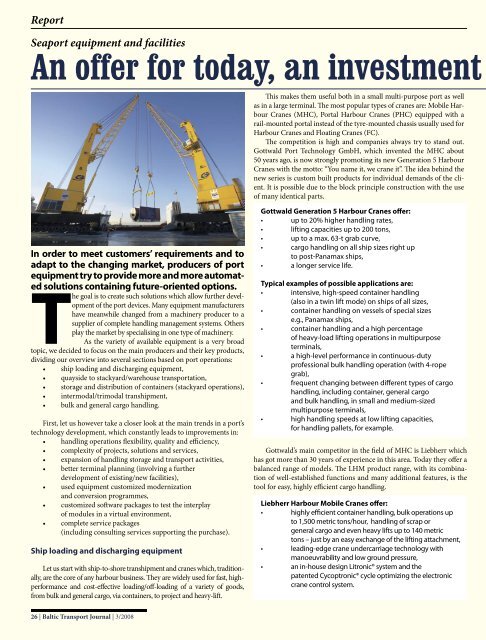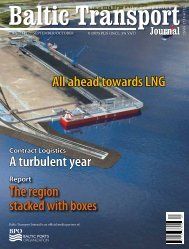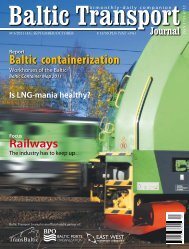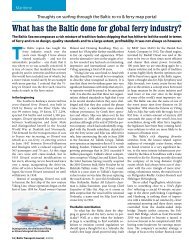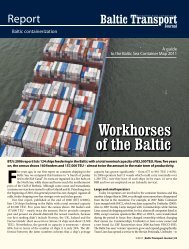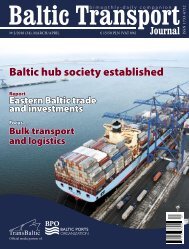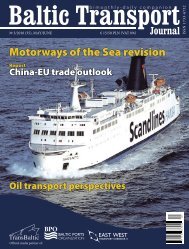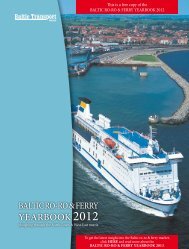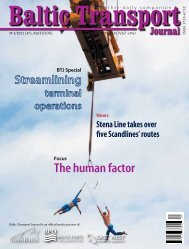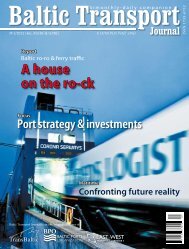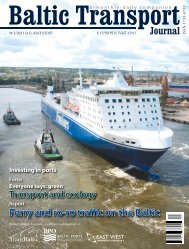Create successful ePaper yourself
Turn your PDF publications into a flip-book with our unique Google optimized e-Paper software.
Report<br />
Seaport equipment and facilities<br />
An offer for today, an investment<br />
In order to meet customers’ requirements and to<br />
adapt to the changing market, producers of port<br />
equipment try to provide more and more automat-<br />
ed solutions containing future-oriented options.<br />
The goal is to create such solutions which allow further development<br />
of the port devices. Many equipment manufacturers<br />
have meanwhile changed from a machinery producer to a<br />
supplier of complete handling management systems. Others<br />
play the market by specialising in one type of machinery.<br />
As the variety of available equipment is a very broad<br />
topic, we decided to focus on the main producers and their key products,<br />
dividing our overview into several sections based on port operations:<br />
• ship loading and discharging equipment,<br />
• quayside to stackyard/warehouse transportation,<br />
• storage and distribution of containers (stackyard operations),<br />
• intermodal/trimodal transhipment,<br />
• bulk and general cargo handling.<br />
First, let us however take a closer look at the main trends in a port’s<br />
technology development, which constantly leads to improvements in:<br />
• handling operations flexibility, quality and efficiency,<br />
• complexity of projects, solutions and services,<br />
• expansion of handling storage and transport activities,<br />
• better terminal planning (involving a further<br />
development of existing/new facilities),<br />
• used equipment customized modernization<br />
and conversion programmes,<br />
• customized software packages to test the interplay<br />
of modules in a virtual environment,<br />
• complete service packages<br />
(including consulting services supporting the purchase).<br />
Ship loading and discharging equipment<br />
Let us start with ship-to-shore transhipment and cranes which, traditionally,<br />
are the core of any harbour business. They are widely used for fast, highperformance<br />
and cost-effective loading/off-loading of a variety of goods,<br />
from bulk and general cargo, via containers, to project and heavy-lift.<br />
26 | <strong>Baltic</strong> <strong>Transport</strong> <strong>Journal</strong> | 3/<strong>2008</strong><br />
This makes them useful both in a small multi-purpose port as well<br />
as in a large terminal. The most popular types of cranes are: Mobile Harbour<br />
Cranes (MHC), Portal Harbour Cranes (PHC) equipped with a<br />
rail-mounted portal instead of the tyre-mounted chassis usually used for<br />
Harbour Cranes and Floating Cranes (FC).<br />
The competition is high and companies always try to stand out.<br />
Gottwald Port Technology GmbH, which invented the MHC about<br />
50 years ago, is now strongly promoting its new Generation 5 Harbour<br />
Cranes with the motto: “You name it, we crane it”. The idea behind the<br />
new series is custom built products for individual demands of the client.<br />
It is possible due to the block principle construction with the use<br />
of many identical parts.<br />
Gottwald Generation 5 Harbour Cranes offer:<br />
• up to 20% higher handling rates,<br />
• lifting capacities up to 200 tons,<br />
• up to a max. 63-t grab curve,<br />
• cargo handling on all ship sizes right up<br />
to post-Panamax ships,<br />
• a longer service life.<br />
Typical examples of possible applications are:<br />
• intensive, high-speed container handling<br />
(also in a twin lift mode) on ships of all sizes,<br />
• container handling on vessels of special sizes<br />
e.g., Panamax ships,<br />
• container handling and a high percentage<br />
of heavy-load lifting operations in multipurpose<br />
terminals,<br />
• a high-level performance in continuous-duty<br />
professional bulk handling operation (with 4-rope<br />
grab),<br />
• frequent changing between different types of cargo<br />
handling, including container, general cargo<br />
and bulk handling, in small and medium-sized<br />
multipurpose terminals,<br />
• high handling speeds at low lifting capacities,<br />
for handling pallets, for example.<br />
Gottwald’s main competitor in the field of MHC is Liebherr which<br />
has got more than 30 years of experience in this area. Today they offer a<br />
balanced range of models. The LHM product range, with its combination<br />
of well-established functions and many additional features, is the<br />
tool for easy, highly efficient cargo handling.<br />
Liebherr Harbour Mobile Cranes offer:<br />
• highly efficient container handling, bulk operations up<br />
to 1,500 metric tons/hour, handling of scrap or<br />
general cargo and even heavy lifts up to 140 metric<br />
tons – just by an easy exchange of the lifting attachment,<br />
• leading-edge crane undercarriage technology with<br />
manoeuvrability and low ground pressure,<br />
• an in-house design Litronic® system and the<br />
patented Cycoptronic® cycle optimizing the electronic<br />
crane control system.


